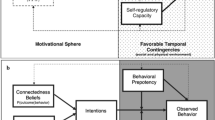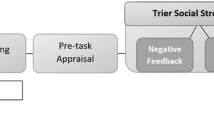Abstract
In an effort to further study the predictions of recent cognitive models of self-regulation with regard to self-observational processes (Kanfer, 1970; Bandura, 1974), an experimental paradigm involving the reactive effects of self-monitoring was used. The saliency of the effects of self-monitored smoking frequency were directly manipulated by varying exposure to qualitatively different amounts of physiological feedback from carbon monoxide (CO) assessment. The meaning of CO feedback was also manipulated by pairing CO with exercise. Forty moderate smokers were matched on their motivation to quit smoking and assigned to one of five conditions: (1) Interview control, (2) Exercise control, (3) Enhanced CO, no exercise, (4) Enhanced CO and exercise (separate), and (5) Enhanced CO and exercise combined. (This was an attempt to take advantage of the inevitable decrease of carbon monoxide that occurs with exercise, thereby further enhancing CO saliency.) Results showed that the reactivity of self-monitoring was significantly increased relative to either of the controls (groups 1 or 2) by exposure to frequent CO feedback (groups 3, 4, and 5). Attempting to further increase the effects of reactivity of self-monitoring by demonstrating an immediate reduction in CO following exercise (group 5) did not result in additional reactivity.
Similar content being viewed by others
References
Abrams, D. B., & Wilson, G. T. (1979). Self-monitoring and reactivity in the modification of cigarette smoking.Journal of Consulting and Clinical Psychology, 47 243–251.
Astrand, P. O., & Rhyming, I. (1954). A nomogram for calculation of aerobic capacity (physical fitness) from pulse rate during submaximal work.Journal of Applied Physiology, 7 218–221.
Astrand, P. O., & Rodahl, K. (1970).Textbook of work physiology. New York: McGraw-Hill.
Bandura, A. (1974). Behavior theory and models of man.American Psychologist, 29 859–869.
Bandura, A. (1977).Social learning theory. Englewood Cliffs, New Jersey: Prentice-Hall.
Broden, M., Hall, R. V., & Mitts, B. (1971). The effect of self-recording on the classroom behavior of two eighth grade students.Journal of Applied Behavioral Analysis, 4 191–199.
Brundin, T. (1980). Effects of tobacco smoking on the blood temperature during exercise.Acta Physiological Scandinavica Supplement, 479 43–47.
Butts, N. K., & Golding, L. A. (1979). Effect of 24 hours of smoking withdrawal on cardiorespiratory functions at rest and exercise.Journal of Sports Medicine and Physical Fitness, 19(4), 389–396.
Colletti, G., Supnick, J. A., & Abueg, F. R. (1982). Assessment of the relationship between self-reported smoking rate and Ecolyzer measurement.Addictive Behaviors, 7 183–188.
deVries, A. A., & Klafs, C. E. (1965). Predictions of maximal oxygen intake from submaximal tests.Journal of Sports Medicine and Physical Fitness, 5 207–214.
Frederiksen, L. W., & Martin, J. E. (1979). Carbon monoxide and smoking behavior.Addictive Behaviors, 4 21–30.
Fremouw, W. J., & Brown, J. P., Jr. (1980). The reactivity of addictive behaviors to self-monitoring: A functional analysis.Addictive Behaviors, 5 209–217.
Gottman, J. M., & McFall, R. M. (1972). Self-monitoring effects in a program for potential high school dropouts: A time-series analysis.Journal of Consulting and Clinical Psychology, 39 273–281.
Hawkins, L. H. (1976). Blood carbon monoxide levels as a function of daily cigarette consumption and physical activity.British Journal of Industrial Medicine, 33 123–125.
Hawkins, L., Cole, P., & Harris, J. (1976). Smoking habits and blood carbon monoxide levels.Environmental Research, 11(3), 310–318.
Henningfield, J. E., Stitzer, M. L., & Griffiths, R. R. (1980). Expired air carbon monoxide acculmulation and elimination as a function of cigarettes smoked.Addictive Behaviors, 5 265–272.
Herbert, E. W., & Baer, D. M. (1972). Training parents as behavior modifiers: Self-recording of contingent attention.Journal of Applied Behavioral Analysis, 5 139–149.
Horan, J. J., Hackett, G., & Lindberg, S. E. (1978). Factors to consider when using expired air carbon monoxide in smoking assessment.Addictive Behaviors, 3 25–28.
Israel, A. C., Raskin, P. A., & Prowder, M. D. (1979). The effects of self-monitoring of smoking and awareness of accuracy feedback upon a concurrent behavior.Addictive Behaviors, 4 199–203.
Kanfer, F. H. (1970). Self-regulation: Research, issues and speculations. In C. Neuringer & J. L. Michael (Eds.),Behavior modification in clinical psychology (pp. 178–220). New York: Appleton-Century-Crofts.
Kazdin, A. E. (1974). Reactive self-monitoring: The effects of response desirability, goal setting, and feedback.Journal of Consulting and Clinical Psychology, 43 637–646.
Lando, H. A. (1975). An objective check upon self-reported smoking levels: A preliminary report.Behavior Therapy, 6 547–549.
Mahoney, M. J. (1974).Cognition and behavior modification. Cambridge, Massachusetts: Ballinger.
Mahoney, M. J., Moore, B. S., Wade, T. C., & Moura, N. G. N. (1973). The effects of continuous and intermittent self-monitoring on academic behavior.Journal of Consulting and Clinical Psychology, 41 65–69.
McFall, R. M. (1970). Effects of self-monitoring on normal smoking behavior.Journal of Consulting and Clinical Psychology, 35 135–142.
Nelson, R. O. (1977). Self-monitoring: procedures and methodological issues. In J. D. Cone & R. P. Hawkins (Eds.),Behavioral assessment: New directions in clinical psychology (pp. 217–254). New York: Brunner/Mazel.
Prue, D. M., Krapfl, J. E., & Martin, J. E. (1981). Brand fading: the effects of gradual changes to low tar and nicotine cigarettes on smoking rate, carbon monoxide, and thiocyanate levels.Behavior Therapy, 12(3), 400–416.
Rachlin, H. (1974). Self-control.Behaviorism, 2 94–107.
Romanczyk, R. G. (1974). Self-monitoring in the treatment of obesity: Parameters of reactivity.Behavior Therapy, 5 531–540.
Ryan, A. J., & Allman, F. L., Jr. (Eds.). (1974).Sports medicine. New York: Academic Press.
Author information
Authors and Affiliations
Rights and permissions
About this article
Cite this article
Abueg, F.R., Colletti, G. & Kopel, S.A. A study of reactivity: The effects of increased relevance and saliency of self-monitored smoking through enhanced carbon monoxide feedback. Cogn Ther Res 9, 321–333 (1985). https://doi.org/10.1007/BF01183851
Issue Date:
DOI: https://doi.org/10.1007/BF01183851




